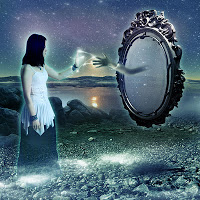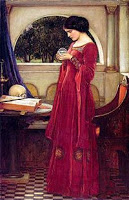Magic Mirrors: A Waking Dream practice

Prior to the thirteenth century and as far back as the 3rd century BCE, mirrors were predominantly polished pieces of metal–gold, silver and brass, though these disappeared when the Christian church during the Middle Ages banned them because it was thought that the devil was watching from the other side of the mirror. This idea was probably reinforced because witches were said to use them for all kinds of dark spell casting. Glass mirrors showed up again in Venice in the 1200s. Though used to aid the vanities they have also been used as a focusing instrument to still the mind and lay open the secrets of the inner psyche.
Mirrors in dreams can be used to reveal a great deal about ones self or about the world around them
To see a mirror in your dream may be to hold a mirror up to yourself–to observe, or judge your own behavior–to assess yourself, perhaps to hold yourself accountable. It is also a symbol for the concern one may have over their public image, or even the image one has of their self, this reminds me of one person’s dream where they envisioned two mirrors turned toward each other with a reflection of the dreamer superimposed on each.
But they are only reflecting the ego-self not the essence of self. The fable that a vampire’s reflection is not seen in a mirror because he has no soul is of course an old wives tale, because the essence of who we are is never reflected. But to lose your reflected ego-image is to have become completely dissociated from the image you have created in the world–to be totally dissociated from the reality around you.
As in Harry Potter the Mirror of Erised is a mirror that reflects desirE–something you wish you had or were. This kind of reflection can trap us in our own desires as they almost did with Harry. It is in these entrapment's that the dream sometimes provides the guidance of a wise old man, or wizard in this case, to help us out of ourselves.
One can also be further bewitched by what is reflected in a mirror, much as Narcissus who fell in love with his own reflection in a pool, each of us can become captivated by our own ego-reflections and lose sight of our deeper selves. Or because a pool of water is like a pool of ones emotions, it might be like looking into your unconscious to see who you are. Mythology is replete with those who are enchanted by their own reflections and thus cut off from their deeper meaning e.g. a mythical Greek nymph who was in love with the sound of her own voice, or Pygmalion, the sculptor, who fell in love with his own creation–both ego-projection myths.
Mirrored dressing tables have been called “vanities” the irony of which is probably not accidental. For this reason a mirror table in a dream can symbolize excessive vanity, or self-pride on behalf of the dreamer.
A broken mirror could portend bad luck or a cracked public image i.e. a besmirched reputation. The ancient Romans worried that if a mirror were to be distorted, or broken in some way that this would do the same to the soul of he who was reflected in it. If broken it could literally capture ones soul amongst the broken pieces. This may be what happened to the soul of Harry Potter’s wizard mentor, Professor Dumbledore.
The evil queens plea for the mirror to reflect upon the “most beautiful of them all” was only a surface reflection subject to the vagaries of time and the competition of others i.e. Snow White represented the youth lost by the queen and therefore reflected what she no longer could lay claim to.
Mirrors have always been used to reflect the face, the image of yourself that you want to present to the world and is therefore an extension of your ego-self.
In the play The Picture of Dorian Gray, Oscar Wilde used a portrait as a mirror to the true image of its debauched subject.
The phrase, “Smoke and mirrors” suggests illusion and deceit in that all may not be as it seems when the image of a mirror enters the scene.
Alice traveling through the looking glass was an adventure into a little girl’s behavior and fantasy, a portal into her imagination, in short, a snapshot or a reflection of her inner life, her fears, confusion, youthful arrogance, and jealousies. As with Harry Potter, Alice desired to see something other than what she had. Alice was all about engaging boredom and curiosity and this was reflected in her adventures beyond the Mirror.
Some mirrors are used by witches and diviners to see what is to happen or what is happening elsewhere. The mirror is black and doesn’t reflect what is in front of it. This form of divining is called scrying and is similar to crystal ball gazing. This may be a symbol for looking for guidance and direction, or an answer to a question about the world around you. I believe that with practice one can use a scrying mirror to reinforce our innate ability to tap into the intuitive part of our psyche for guidance.
Those ancient black scrying (from descry–to see or perceive) mirrors used for divination by witches and sorcerers were once made black by using asphaltum painted on the glass three times. I’ve mentioned earlier this technique for foretelling the future, or being able to “see” what is happening from distances, but is this real?

The Crystal Ball by John Waterhouse, 1902
I imagine the staring at crystal balls, or scrying mirrors to be similar to focused meditation. Try closing your eyes in a meditation and focus on an individual, place, or event and “see” what you get.
In Corinthians 13:12 is the line, "For now we see through a glass, darkly." Which some have taken to mean that to see something reflected in a mirror is less of the reality of that thing than to gaze upon it directly. This can happen when one looks back upon their childhood, or try to see what the child saw of the world, or to assign meaning to past events, or to look at God’s works through ones biases. To look through a window, or gaze at a mirror that has been darkened by your judgments and self-criticisms makes it difficult to see your true nature. This also reminds me of the saying involving “rose colored glasses.” To look through either does not give a true picture of the world.
As Rumi, the 13th century Muslim poet was purported to have said,
“Maybe you should glimpse your most beautiful face…Maybe you are the bearer of hidden treasure. Maybe you always have been.”
I have heard it said and have tried this myself, that if you are feeling blue, or anxious with no one around to talk to, try staring into your eyes reflected in a mirror. After awhile the negative mood will disappear.
An ancient tradition still exercised in Tibet uses a divination called the Lake of Vision, or tra divination. In this tradition a tra diviner will concentrate by clearing his mind on a reflective surface such as a lake, or a mirror and conjure visions of what lies ahead, thus they are used to guide, much as they might as a symbol in a dream. This technique has been used as a part of the process for determining a new Dalai Lama.
In a dream to see a side-view mirror or a rear view mirror in a car can suggest that something may be creeping up behind you, or a warning to watch your back, or something from the past is making itself known.
In physics some mirrors are constructed in a way that certain reflected wavelengths can be filtered out. This is not unlike some dream mirrors that filter out the ego-reflection of the conscious world leaving information projected from the unconscious world.
Because dreams may be projections from your inner self, your unconscious, then mirrors of all kinds are the reflections of your own inner shadows, thoughts, judgments, and beliefs as well, perhaps, the work of and projections of your soul.
This saying of course has at least two meanings.
What you see there is an indication of what in your life you most need to work on, work through, or work with. What we see isn’t always pretty, but as with all dreams what is reflected is there for our personal health and well-being.
The waking world can be a mirror to our inner projections as well in that what we tend to see is what we believe and is reflected out there in the world– what we see reflects back onto ourselves, which reflects back onto what we see. The world and we are like mirrors facing one another. If you want to know something about what is going on with you, just notice what’s going on around you. Our world is like a House of Mirrors–all distorted by our perceptions and points-of-view and a dream of mirrors can provide information about these distortions.
In the Archipelago of Dreams (2011) Robert is constantly entrapped by his own reflections and struggles to find his own true self among the distorted images not only of the Spirit world in which he finds himself, but in the world of Being he inhabits normally. Robert also discovers that mirrors can only reflect subjective objects or people. When one functions through their spirit, the space of being beyond the subjective illusion, the subjective reflection fades. It's not that a person who shows no reflection has no soul (as is said about vampires), but that they are a person who has gone beyond the objective illusion of the body.
|